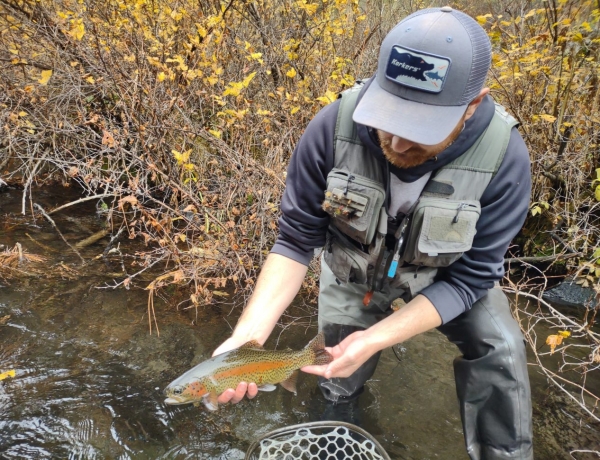Water temperatures are starting to drop, and that means a few things in the Central Oregon fishing world. More steelhead and salmon are pushing up the Deschutes, big streamer-eating trout are getting active, and classic hatches like October caddis and blue wing olives are returning. It also means that leak in your waders you got back in June is finally starting to become a problem. No one wants water in their waders, especially as the colder months approach. Luckily, we’ve been there too. Here’s a simple guide to getting those waders back into shape and keeping you dry this winter.
Finding the Leak
This first step is usually the trickiest part to successfully fixing your waders. Making sure you actually know where water is entering will save you time backtracking later and guarantee that the leak is fully plugged during the repair process. There’s a couple different methods for doing this, depending on the material of your waders. (disclaimer- we’re not including neoprene wader repairs, as most modern waders no longer use this material).
For waders using Gore-Tex (Simms Classic Guide, G3, etc.), turn them inside out and simply apply rubbing alcohol to the area where you suspect a leak. Leaks will show up darker, and you can mark spots with a pen to find them after the alcohol dries.
For non Gore-Tex nylon waders (Redington Escapes, Sonic Pros etc.), turn the waders inside out, get yourself a hose, and fill them with water. You won’t need to fill the waders all the way, just a little above where you think they’re leaking. If it’s a higher up leak, such as the crotch area, it may be helpful to have another person help you hold them up as you look for leaks. Then, look for water coming out. Circle the leaks, turn the waders back from inside out, and let them dry. If there’s a pretty significant leak, you may have to turn them inside out again to let the neoprene booties dry. Lots of water coming out during the testing will get them wet on both sides, and you ideally want the waders to be dry before you start repairs.
Repairing the Leak
Once you’ve found them, repairing leaks in waders is fairly straightforward. First, turn the waders inside out again. For small pinhole leaks, we recommend repairing waders from the inside. The outside of your waders is just an abrasion resistant material, and the actual leak is where the membrane itself has been penetrated. Larger leaks and gashes can be repaired from both sides, for extra insurance. However, make sure to tape over one side of larger tears before repairs or you’ll glue the two sides of the waders together!
For repairs, place the area being fixed on a level surface. Then, liberally apply waterproofing adhesive on and around the leak. We strongly recommend using Aquaseal by Gear Aid, which we use on our rental waders and own personal equipment. After covering the leak, let the adhesive set on a flat surface (which can take up to 12 hours). After the adhesive dries, you’re good to go. However, it’s not a bad idea to make sure your repair holds by testing your waders the same way you initially looked for leaks.
It’s important to note that while this method will patch most leaks, there’s a few instances where using waterproof adhesive won’t totally fix the problem. The most common situation is leaks on the seams of waders. The location of the leak allows water to spread along the seam and come out somewhere else, making it difficult to fully control once a leak appears.
Need to seal up a leak, or have questions about the repair process? Come on by the shop to pick up some Aquaseal and run some questions by us. Until then, stay dry out there.


